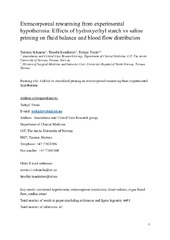Blar i forfatter "Schanche, Torstein Lindahl"
-
Autoregulation of Cerebral Blood Flow During 3-h Continuous Cardiopulmonary Resuscitation at 27°C
Valkov, Sergei; Nilsen, Jan Harald; Mohyuddin, Rizwan; Schanche, Torstein Lindahl; Kondratyev, Timofey; Sieck, Gary C.; Tveita, Torkjel (Journal article; Tidsskriftartikkel; Peer reviewed, 2022-06-09)Introduction: Victims of accidental hypothermia in hypothermic cardiac arrest (HCA) may survive with favorable neurologic outcome if early and continuous prehospital cardiopulmonary resuscitation (CPR) is started and continued during evacuation and transport. The efficacy of cerebral autoregulation during hypothermic CPR is largely unknown and is aim of the present experiment.<p> <p>Methods: ... -
Effects of rewarming with extracorporeal membrane oxygenation to restore oxygen transport and organ blood flow after hypothermic cardiac arrest in a porcine model
Nilsen, Jan Harald; Schanche, Torstein Lindahl; Valkov, Sergey; Mohyuddin, Rizwan; Håheim, Brage; Kondratyev, Timofey; Næsheim, Torvind; Sieck, Gary C.; Tveita, Torkjel (Journal article; Tidsskriftartikkel; Peer reviewed, 2021-09-23)We recently documented that cardiopulmonary resuscitation (CPR) generates the same level of cardiac output (CO) and mean arterial pressure (MAP) during both normothermia (38 °C) and hypothermia (27 °C). Furthermore, continuous CPR at 27 °C provides O2 delivery (ḊO2) to support aerobic metabolism throughout a 3-h period. The aim of the present study was to investigate the effects of extracorporeal ... -
Enhanced Blood Clotting After Rewarming From Experimental Hypothermia in an Intact Porcine Model
Schanche, Torstein Lindahl; Filseth, Ole Magnus; Østerud, Bjarne; Kondratyev, Timofey; Sieck, Gary C.; Tveita, Torkjel (Journal article; Tidsskriftartikkel; Peer reviewed, 2022-04-29)Introduction: Due to functional alterations of blood platelets and coagulation enzymes at low temperatures, excessive bleeding is a well-recognized complication in victims of accidental hypothermia and may present a great clinical challenge. Still, it remains largely unknown if hemostatic function normalizes upon rewarming. The aim of this study was to investigate effects of hypothermia and rewarming ... -
Extracorporeal rewarming from experimental hypothermia: Effects of hydroxyethyl starch versus saline priming on fluid balance and blood flow distribution
Schanche, Torstein Lindahl; Kondratyev, Timofey; Tveita, Torkjel (Journal article; Tidsskriftartikkel; Peer reviewed, 2019-08-29)Rewarming by extracorporeal circulation (ECC) is the recommended treatment for accidental hypothermia patients with cardiac instability. Hypothermia, along with initiation of ECC, introduces major changes in fluid homeostasis and blood flow. Scientific data to recommend best practice use of ECC for rewarming these patients is lacking, and no current guidelines exist concerning the choice of priming ... -
Study of the effects of 3 h of continuous cardiopulmonary resuscitation at 27°C on global oxygen transport and organ blood flow
Nilsen, Jan Harald; Valkov, Sergei; Mohyuddin, Rizwan; Schanche, Torstein Lindahl; Kondratiev, Timofei V.; Næsheim, Torvind; Sieck, Gary C.; Tveita, Torkjel (Journal article; Tidsskriftartikkel; Peer reviewed, 2020-04-16)<i>Aims</i>: Complete restitution of neurologic function after 6 h of pre-hospital resuscitation and in-hospital rewarming has been reported in accidental hypothermia patients with cardiac arrest (CA). However, the level of restitution of circulatory function during long-lasting hypothermic cardiopulmonary resuscitation (CPR) remains largely unknown. We compared the effects of CPR in replacing ...


 English
English norsk
norsk



